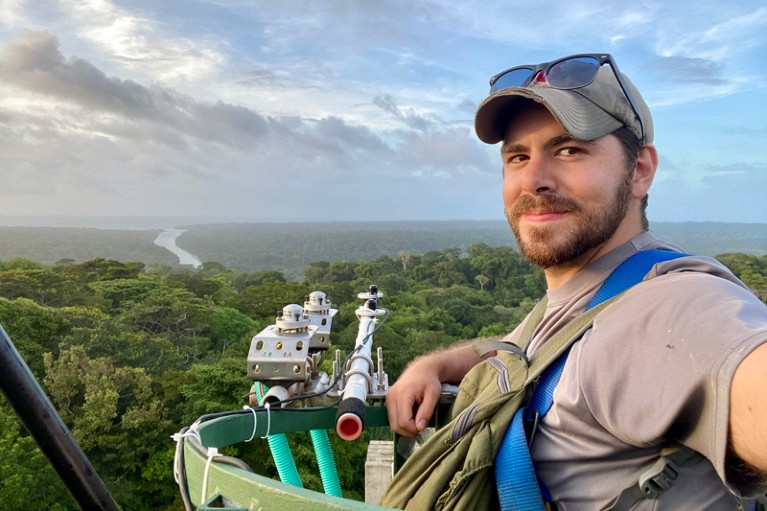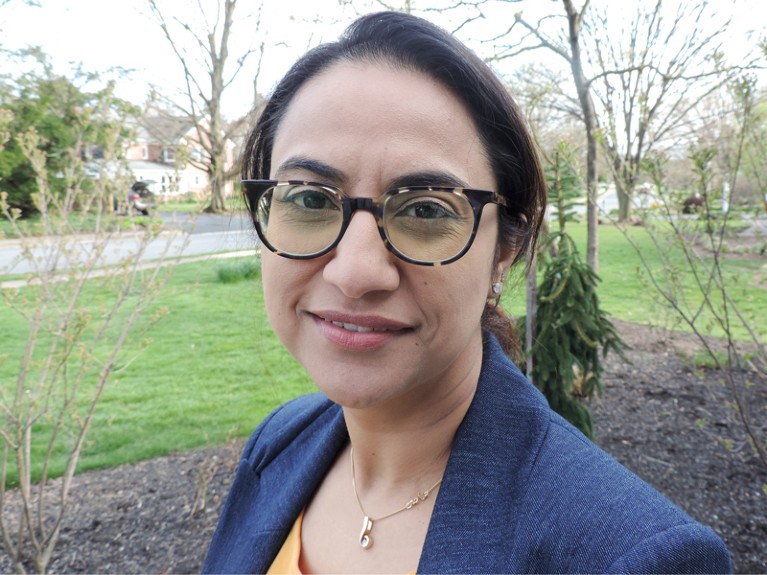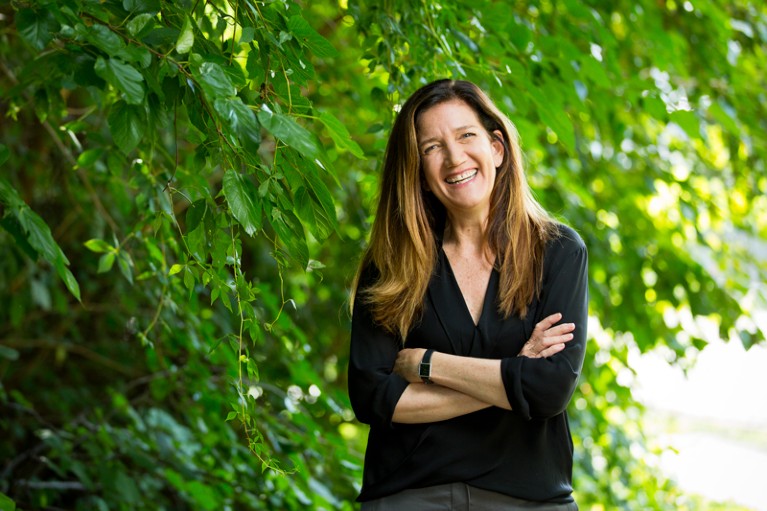
Now a analysis scientist at The Nature Conservancy’s Nachusa Grasslands, Elizabeth Bach used her ardour for the prairie to chart her profession path.Credit score: Dee Hudson
As a graduate pupil, Shradda Dhungel studied how air pollution transfer by way of the Himalayan valleys in Nepal — her house nation. That sensible expertise led her in an sudden route: working at an environmental non-governmental group (NGO).
After incomes her PhD in environmental science on the College of Virginia in Charlottesville in 2017, Dhungel taught undergraduates bodily science and ecology on the Style Institute of Know-how in New York Metropolis. By way of instructing, she realized that she cherished sharing scientific information with the general public. Finally, Dhungel concluded that she needed her work to have a sensible affect on folks and policymaking.
So, in 2021, she utilized for a postdoctoral place on the Environmental Protection Fund (EDF), a science-led environmental group in New York Metropolis. She now works to mitigate international and regional ranges of methane, to assist inform policymaking and encourage efforts to curb emissions of the greenhouse fuel.
Working for the EDF, Dhungel’s utilized analysis instantly helps folks and the planet, which she says is her calling. (Dhungel completed her EDF postdoctoral programme earlier this month and is now on the lookout for a full-time scientist place at different climate-focused non-profit organizations.)
Dhungel is amongst a small however comparatively steady cohort of graduate college students who’ve left academia for the non-profit sector. Knowledge from the US Survey of Earned Doctorates present that, of all people awarded a PhD in 2021 or 2022, 6.5% — most of whom studied science or engineering — left academia for non-profit organizations. Many scientists working at NGOs needed to see their work make a distinction in communities and the setting, and have the flexibility to affect coverage at early profession phases.
“There’s a likelihood for me to contribute one thing fairly tangible,” says environmental engineer Kashif Shaad, who is predicated in Singapore however works at Conservation Worldwide, an NGO in Arlington, Virginia.
Researchers are key to the work of science-focused environmental non-profit organizations, which regularly conduct initiatives for or in partnership with different teams. Scientists assist to ship proof to tell policymaking and switch findings into sensible options, says Rebecca Shaw, chief scientist on the World Wildlife Fund (WWF), a world wildlife-conservation group in Washington DC. Non-profit organizations want a powerful provide of extremely skilled scientists to assist discover and apply options to international environmental challenges, from local weather change and plastic air pollution to biodiversity crises.For a scientist, day by day work at an environmental non-profit group may be much like that in academia, however there are key variations within the software course of, climbing the profession ladder and publishing analysis.

Kenneth Davidson gained abilities throughout his PhD discipline work on the San Lorenzo Protected Forest (pictured) in Colón, Panama, that ready him for work on the non-profit group American Forests.Credit score: Kenneth Davidson
Many researchers on this sector nonetheless current their work at conferences and publish manuscripts in journals, however publications and citations are usually not their principal measure of success. Extra vital is delivering options to coverage companions, reminiscent of native governments or foundations, and serving to to create real-world change.
Adapting to non-profit work
“I’m nonetheless a researcher. I nonetheless need to get publications on the market. However working with native partnerships is paramount,” says Kenneth Davidson, who final yr earned a PhD in plant physiological ecology at Brookhaven Nationwide Laboratory in Upton, New York. He now works at American Forests, a forest-conservation group in Washington DC.
Wage ranges may be much like these for tutorial posts or barely greater or decrease, relying on the place and dimension of the group. However, Davidson provides, NGOs present extra job safety than academia for early-career scientists, and supply extra flexibility. “Having the ability to begin incomes and saving proper out of grad faculty was an enormous draw to a non-academic path,” he says.
To efficiently transition to non-profit work, lecturers should shift their mindset, recognizing that their analysis should all the time have sensible purposes for real-world challenges. At an NGO, science isn’t achieved simply within the pursuit of data.
“You’re actually listening deeply to the problems at hand, and the struggles individuals are having. You’re growing questions and analyses to deal with these challenges,” explains Shaw.
Environmental non-profit teams are available in many sizes and flavours, and the roles for scientists can differ relying on the group’s scope and mission. Some positions have a powerful analysis focus; others are extra concerned in coverage growth or conservation follow. The WWF, a big international group, employs 27 full-time scientists in its US workplace alone — most of whom have a PhD. It additionally has scientists in its different workplaces, together with 16 in the UK. It affords three postdoctoral fellowships in its US science group and offers funding for PhD candidates and postdocs from Latin America, the Caribbean, Asia and Africa by way of a capacity-building programme. The WWF runs a broad array of analysis initiatives — starting from how one can transition to renewable wind and photo voltaic vitality sources with out dangerous ecological impacts, to investigating the shifts in meals manufacturing and dietary patterns wanted to make sure that all folks have entry to wholesome meals. Against this, American Forests, which is smaller in dimension and scope, employs round 30 scientists in whole, 6 of whom have PhDs.
Dhungel discovered that making use of for her postdoctoral place on the EDF was completely different from the educational hiring course of. As a substitute of submitting a written analysis proposal, she went by way of two rounds of interviews and gave a presentation about her earlier work and related experiences to an viewers not restricted to simply scientists.

Environmental scientist Shradda Dhungel discovered her stride working on the Environmental Protection Fund on utilized analysis that helps the planet.Credit score: Shradda Dhungel
Davidson says that, after finishing his PhD, it took him a couple of tries earlier than he understood how one can adapt his job-seeking methods and purposes to NGOs. He observed that networking processes had been completely different. For instance, in academia, open positions typically flow into by way of phrase of mouth and on social-media platforms reminiscent of X (previously referred to as Twitter). Candidates additionally typically method principal investigators by way of e-mail, introducing themselves and offering hyperlinks to their publication lists.
Against this, discovering non-profit positions includes looking for ads on jobs boards and LinkedIn, an expert networking web site, says Davidson. He shortly spruced up his beforehand sparse LinkedIn profile. Davidson additionally tailor-made his CV to focus on sought-after abilities and experiences within the non-profit sector, specifically ‘gentle abilities’ associated to interacting and collaborating with others.
“It’s the identical instructional background and the identical analysis, however simply the best way that I describe issues needed to shift utterly,” he says. For instance, for an instructional viewers, Davidson targeted extra on the scientific particulars of his analysis; for an NGO, he emphasised his expertise partnering with different non-profit organizations and the sensible purposes of his work.
It took Davidson about six months to land his job at American Forests, the place he fashions ecosystem carbon flux to assist the Oregon Division of Forestry assess forest carbon and adjust to emissions reporting necessities. Displaying how your analysis is related to coverage or environmental follow is essential to getting your foot within the door, Davidson says.
Additionally, candidates who can display expertise in collaborating with companions exterior academia will go additional, says Davidson. For instance, throughout the fourth yr of his PhD programme, he spent a summer time engaged on a venture for Black Rock Forest, a non-profit analysis group in Cornwall, New York, the place he checked out how the associations between leaf traits and water-use effectivity fluctuate throughout a rising season. The venture was separate from his PhD, however in the end contributed a chapter to his thesis — and doubtless strengthened his job purposes, he says. This expertise additionally confirmed him what working for a non-profit group is like.
Elizabeth Bach, an ecosystem-restoration scientist on the international non-profit The Nature Conservancy (TNC), who is predicated in Franklin Grove, Illinois, took a unique method. Even whereas pursuing her PhD in ecology and evolutionary biology at Iowa State College in Ames in 2010–14, she knew that she didn’t need a typical educational profession.

Rebecca Shaw, chief scientist on the World Wildlife Fund, says that non-profit work requires researchers to seek out sensible purposes of science to deal with real-world challengesCredit score: WWF-US/Rebecca Drobis
“I completely love the tallgrass prairies of the Midwest,” she says, which is the place she grew up. Her ardour for this at-risk ecosystem helped to chart her profession path. On the finish of her PhD programme, she regarded for postdoctoral alternatives that may give her applied-science expertise. In 2014, she turned a postdoc on the Illinois Pure Historical past Survey on the College of Illinois Urbana-Champaign, the place she catalogued and studied the variety and ecology of the state’s fauna and flora to assist inform administration of pure assets.
“It was a foot within the educational world and a foot on this planet of utilized science,” she says.
Two years later, she started a second postdoctoral programme, with a stronger deal with science coverage, on the International Soil Biodiversity Initiative, a world collaboration to tell the general public and policymakers on soil well being, based mostly at Colorado State College in Fort Collins.
In 2018, her earlier applied-science and coverage experiences landed her at her dream job on the TNC, she says. She leads a analysis programme on the Nachusa Grasslands nature protect in Illinois, inspecting tallgrass-prairie restoration ecology. Bach’s analysis focuses on how soil and life beneath floor help tallgrass-prairie ecosystems by way of plant and soil interactions and nutrient and carbon biking. She advises others who need to work at a non-profit group to intentionally construct up related technical abilities by way of postdoctoral programmes and different alternatives, reminiscent of volunteering.
Perks of the non-profit path
Scientists working within the non-profit sector will sometimes spend much less time within the laboratory than will these in academia, however this could depend upon the job and the group, says Shaw. Dhungel says her workdays on the EDF are spent doing analysis and analysing knowledge, mirroring her educational days. Against this, Bach’s job includes hands-on land administration on the nature protect, together with serving to to coordinate prescribed fires and making selections about planting new prairies and defending present ones, along with working a analysis venture.
Dhungel enjoys different perks in her non-profit place. At the same time as a postdoc, she will be able to work with exterior companions and contribute on to policymaking. She feels that, if she had an instructional place, this wouldn’t occur till a lot later profession phases.
And though environmental NGOs use cutting-edge science for sensible purposes, reminiscent of growing insurance policies or conservation practices, the work remains to be intellectually stimulating, says Davidson. The utilized science that non-profit teams pursue is commonly what attracts researchers to hitch their trigger.
Shaad loves that his job entails working with and studying from native communities and conservation practitioners. “There are such a lot of passionate folks on the bottom. I get to study from them and place that in my very own universe of occupied with issues,” he says.
In 2015, Shaad accomplished a postdoctoral programme at Conservation Worldwide, the place he helped to develop a system to guage the well being of freshwater ecosystems in Jakarta. He has been on the group ever since, and now heads a freshwater-conservation programme. Shaad was drawn to researching water points after rising up in Bhopal, India, within the aftermath of a poisonous fuel leak in 1984 from US agency Union Carbide’s pesticide plant, which killed hundreds and contaminated the realm’s groundwater.
He earned his PhD in environmental engineering at Swiss Federal Institute of Know-how (ETH) Zurich and says that transitioning to non-profit work includes a “steep studying curve”. It helps to be humble and to speak to individuals who have constructed information and experience by way of non-academic routes, he advises.
Leaving academia may be scary and tough to discover overtly, owing to worry of dropping help from supervisors, says Shaw. “Academia could make you’re feeling very unhealthy for not selecting it,” she says. However, she advises, in case your coronary heart isn’t in it, then “simply make the leap”.